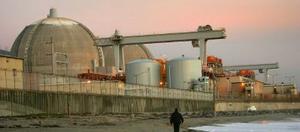California's nuclear reactorsCalifornians anxious about safety of nuclear reactors
The parallels between Japan and California are sobering: As in Japan, California’s two plants — Diablo Canyon near San Luis Obispo and San Onofre in Southern California — sit in active earthquake zones; like Japan’s, both rest beside the ocean and were built more than a quarter-century ago; perhaps most troubling, the San Onofre plant straddles two counties in Southern California with a combined population of 6 million people

California's San Onofre nuclear power plant // Source: scpr.org
With TV screens full of disturbing images from Japan, Californians are asking whether the state’s two active plants, as well as a number of shuttered facilities still holding radioactive waste, are vulnerable to the same sort of chain reaction that has brought the world to the brink of a nuclear cataclysm.
The San Jose Mercury News reports that the parallels are sobering: As in Japan, California’s two plants — Diablo Canyon near San Luis Obispo and San Onofre in Southern California — sit in active earthquake zones. Like Japan’s, both rest beside the ocean and were built more than a quarter-century ago. Perhaps most troubling, the San Onofre plant straddles two counties in Southern California with a combined population of 6 million people.
The utility companies that operate the California plants say they are built to withstand the hardest temblor the local faults are believed to be capable of, some worry that an unexpectedly forceful earthquake could knock out the facilities, spawning a crisis like the one happening right now in Japan.
The Mercury News notes that from a larger perspective, Japan’s crisis raises questions in the United States about its own nuclear-power ambitions. On Monday, a White House spokesman said President Barack Obama continues to count on nuclear power as part of a wide-ranging plan to boost the country’s energy output, cautioning that events in Japan were still too fluid to make any definite changes to the nation’s energy policy. Republican lawmakers encouraged the president to not overreact to the crisis by drawing in the reins too tightly on the nuclear industry. Yet skeptics of nuclear power, including Representative Edward Markey (D-Massachusetts) say the federal government should consider a moratorium on building nuclear plants in seismically active areas.
The Nuclear Energy Institute, a Washington, D.C.-based trade group for the nuclear-power industry, said that despite the crisis in Japan, nuclear power has a key role to play in America’s efforts to wean itself from fossil fuels. Spokesman Carl Baab said that while the current crisis is certainly dire — “and nobody wants to rush ahead helter-skelter without learning the lessons of this very serious accident” — the industry’s “safety record has been improving consistently year after year. Our No. 1 focus has always been and will continue to be safety.”
The operators of the Diablo plant, one of 104 reactors in 31 states, insist there are adequate safeguards in place to make sure that what happened in Japan never happens in the United States.
Diablo Canyon, which occupies a small patch of the utility’s 12,500 acres of rolling coastal hills, has been seismically reinforced over the years since it first opened in 1984. And PG&E officials say that by continual monitoring, upgrading and testing those features, the reactor could withstand even the sort of double-whammy of a quake and tsunami that has crippled the Japanese Fukushima I plant about 150 miles north of Tokyo.
